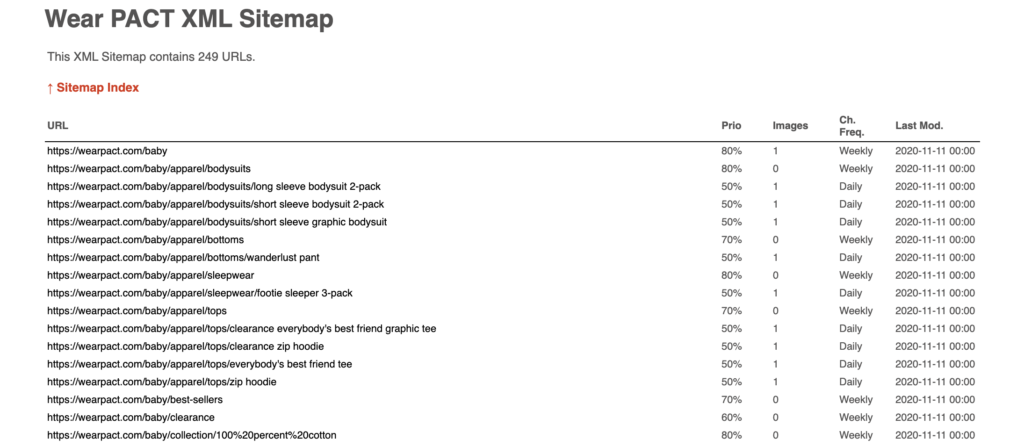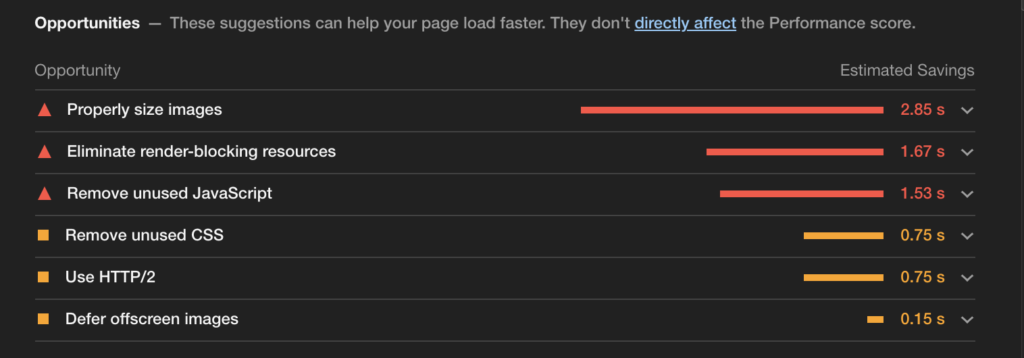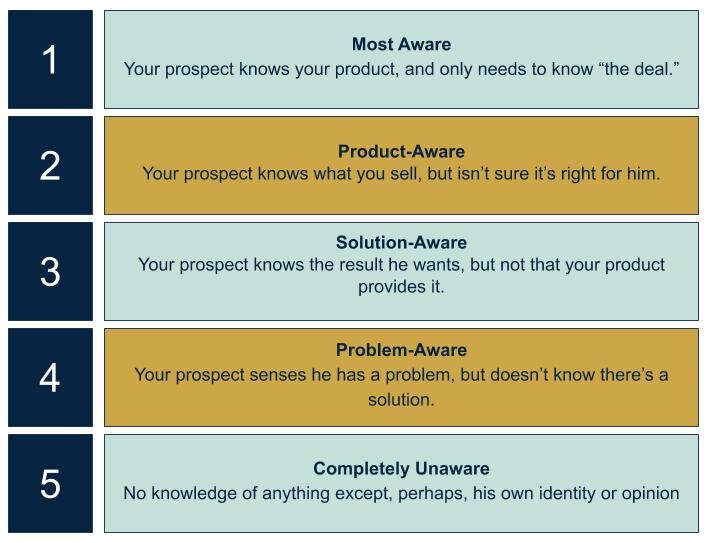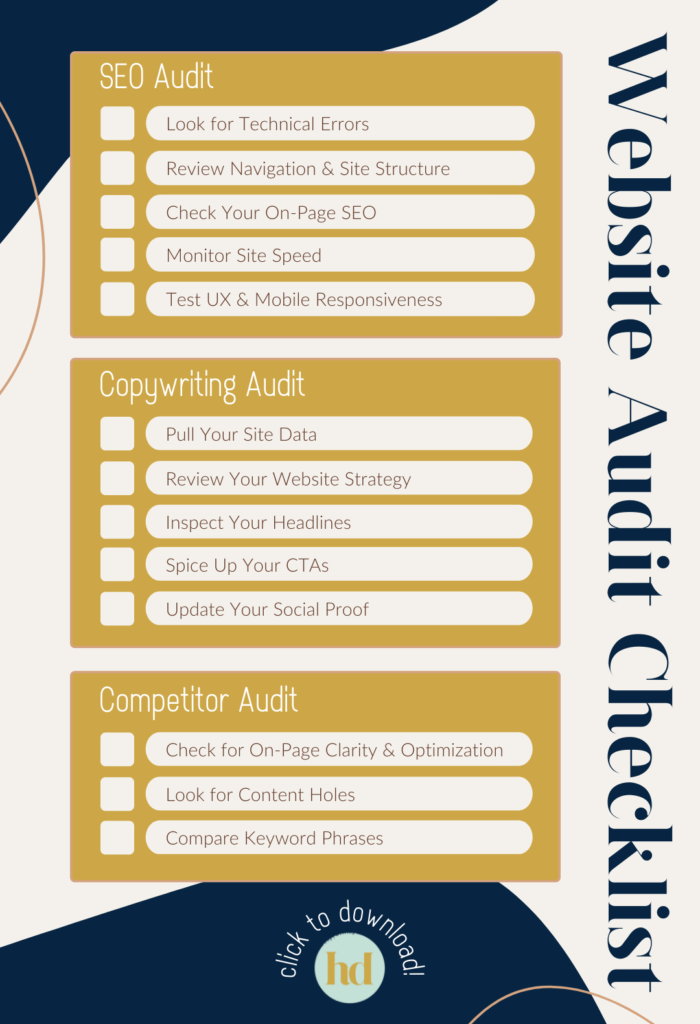

How to audit your website for SEO & copywriting
If you want to get a better sense of how your website is performing in SEO, you need to run regular audits to ensure your site is functioning properly and to identify opportunities to expand your content strategy.
In this article, I’ll walk you through how to run an SEO- and copywriting-focused website audit. I’ll show you what to look for when using this as an auditing tool for your site AND for a bit of friendly spying on your competition.
Before you begin: Pull your sitemap
A sitemap is a useful and practical tool for improving your site’s organization and structure. It speeds up the work that search engine crawlers need to do to scan and assess your site so it can be properly indexed in search. And it helps others more easily navigate your website, creating a better overall user experience.
Most of what you need for your SEO site audit you can get from your sitemap.
There are really two types of sitemaps out there:
- XML sitemaps are used by search engine spiders to extract important information about your site.
- HTML sitemaps are meant for humans and act as a navigational tool on your website.
XML sitemaps are by far more common, but both are useful for improving your SEO.
Here’s an example of human-friendly HTML map:


And a more robot-centric XML map:


For the purpose of a site audit, we’ll focus on XML sitemaps; that said, consider whether your site can benefit from an HTML map, as well.
How to pull your sitemap
There are several methods and dozens of tools to use to pull a sitemap.
I’ve outlined a few in this video:
- Use Google to see all active, searchable pages. This is useful for high-level work, research, and topical content references, but it won’t give you a full breakdown of a site.
- Manually pull an xml sitemap to view a sitemap the way crawlers do
- Manually pull an xml sitemap using a website crawler like Screaming Frog SEO Spider.
3 Ways to quickly pull the sitemap for any website
How to audit your website for SEO
A sitemap offers a complete picture of the structure and health of your website in one bird’s-eye view. It’s easy to get lost in the details when you’re looking for site issues: you can fall down keyword rabbit holes, spend hours looking through your competitors’ sites trying to figure out why they are ahead of you in organic search and get frustrated brainstorming new content for your blog.
A sitemap is a simple approach that can help you get started and keep you on track to tackle the biggest—and most impactful—issues first.
Look for technical errors
Look for 404s. These are deadlinks that can weigh down your site over time and negatively affect your SEO. Also, note 302 redirects. These are meant to be temporary redirects, so it’s a good time to either pull those or make them a longer-term 301.
Review navigation & site structure
Do you have blog posts hanging off the root domain while others are nested under a /blog/ prefix? Are your URLs looking long and confusing? Do you have non-intuitive category pages? Think of your site map as a table of contents for your website. Is yours clear and easy to follow?
Check on-Page SEO
Make sure your active pages have title tags and meta descriptions, proper header formatting (Does every page start with a Header 1? Are you using H2s and H3s properly?)
To complete your SEO audit, there are a few other items to check off your list that you can’t find directly on your sitemap:
Monitor site speed
Your site’s speed on mobile and desktop is arguably one of the top ranking factors in Google search. You can review your site speed using PageSpeed Insights or Lighthouse (both are free to use). Speed is a tricky one. Depending on what website platform you use, you could run into limitations over control to some site-slowing elements like excess Javascript and hosting constraints. That said, there’s still a lot you CAN control around site speed, like compressed images, first load, and contextual paint.


Test UX & mobile responsiveness
Part of user experience is ensuring a seamless customer experience across different browsers and devices. This may mean limiting your copy, widgets, or images on mobile, for example, increasing font size, and switching to a hamburger menu. It’s a good idea to read your site directly to make sure it’s both legible and navigable. Cut anything that’s hard to see or read, or that interferes with your offer.
Across browsers:
- Chrome
- Safari
- Firefox
- Internet Explorer
Across devices:
- Desktop
- Mobile
- Tablet
How to run a copywriting audit for your website
Reviewing your site for conversion may feel more nebulous than the more straightforward data pull of your SEO audit, but it’s still important AND manageable using this checklist.
Here’s what I recommend:
Pull your site data
If you aren’t already tracking site users and engagement, now’s the time to start! You’ll want to know a few things:
- Where your traffic is coming from (organic, social, email, etc.)
- Where readers are landing…and where they’re going
- What pages have the best and worst engagement
I recommend using Google Anaytics along with Search Console (which you can now integrate right into GA) to track user behavior and acquisitions…a direct line to tracking conversion. You can also add a UTM code to your most important marketing URLs and promotional pages, as well as to your email to see how effective they are.
I’d also recommend tracking your heatmaps, scroll data, and user recordings using a tool like Hotjar. That will help you spot errors and watch your customer journey in live time, which is key to making modifications and improving your site experience.
Review your website strategy
Every website is different, and yours needs to serve your goals and your business. That means having clear expectations for your site, tracking those goals, and reviewing them to make sure they still work for you. Look for holes, gaps, and opportunities to tighten your messaging, improve the user experience, and increase conversions.
Inspect your headlines
Headlines are tough, often the most challenging part of your website to write. So it’s a good idea to review them with fresh eyes to make sure they’re conveying the right message about your brand, offers, and value.
- Turn “me” statements into benefits. Focus on the outcome of your services for the reader
- Avoid overly clever. Be clear first, and then layer in personality and wit
- Watch out for headlines that are outdated or don’t reflect today’s offers and audience
Trim your navigation menu
Only show the most important and offer-driven pages across your site. Interlink the others logically. Unless you have a large business with multiple offer types and audiences, stick to just 3-6 top-level menu items, and embed the others.
Spice up your CTAs
Swap out “Learn more” for more exciting, clickable button copy. Try to stick to just one or two CTAs across your site and ditch the vague next steps. Make your CTA clear and memorable so readers can’t resist clicking on it.
- Learn more > See pricing
- Learn more > Start my free trial
- Learn more > Let’s get started
Review your customer journey
Are your offers clear and logical? Do you have an easy-to-find free offer? Is your contact information up-to-date? Your prospect goes through many, many steps before purchasing from you, and it’s your job to usher them through each step on your website.
Review and pay close attention to your top, mid, and bottom of funnel content (AKA ToFu, MoFu, and BoFu content) to help your prospects find their way.


Update your social proof
You worked hard to earn those testimonials, stats, case studies, and brand logos but are they outdated? Make a point to update your social proof to reflect your most recent work and keep your site fresh and relevant.
BONUS: How to audit your competitor’s website
Going back to our sitemap data for a minute, this is one of my favorite ways to use a tool like Screaming Frog because it gives you a ‘look under the hood’ of your competitors’ content and website strategy. Especially when you combing this with a tool like SEMRush, you can get incredibly granular and insightful ideas to drive your content strategy.
Pull the sitemap for a competitor using the same process you used for your own website, and zero in their site structure and content.
On-page clarity
Are they auditing their site? Do they use on-page SEO best practices, clear URL structures, and intuitive organization? If not, you most certainly have a big opportunity to creep ahead of them in organic search by completing this work.
Content holes
Drill into their blog or resources section and spend some time tagging and organizing their content. What are they missing that you know you can add to your site? What do you have that they don’t? What do they have that you don’t?
If you really want to be strategic, compare the content for multiple competitors and look at length, recency, and topical coverage to see where you can make improvements.
By comparing their content to your own, you can generate new ideas for your own website, and see where you—and your competitor—are falling behind.
Keyword opportunities
Try pulling the sitemap for a competitor in your vertical that is always in the top spots in organic search. Then pull a mid-tier competitor. Look through their top-performing content and cross-reference these pages with a keyword tool (I use Keysearch. SEMRush is also excellent and now they have a limited free account option).
Grab the keywords from several competitors and pull them into one sheet (Using VLookup).
Why? Because, by understanding what keywords they’re ranking on, you can create new content and optimize your existing content for these phrases.
What phrases are they all chasing? You should be chasing those, too.
What phrases AREN’T they looking at that you’re already ranking for? That’s content you can review and add to that differentiates your site in search.
Website audit checklist
SEO audit checklist
- Look for technical errors
- Review navigation & site structure
- Check your on-Page SEO
- Monitor site speed
- Test UX & mobile responsiveness
Copywriting audit checklist
- Pull your site data
- Review your website strategy
- Inspect your headlines
- Spice up your CTAs
- Update your social proof
Competitor audit checklist
- Check for on-page clarity & optimization
- Look for content holes
- Compare keyword phrases
Website audit tools
These are the tools I use to audit my site and my clients’ websites. Most are free (or “freemium”) to use.
- Screaming Frog: Download this robust site crawler to your desktop to pull any site’s sitemap (free for up to 500 URLs)
- PageSpeed Insights: Test any site’s speed on desktop and mobile, plus update your site with listed suggestions (that are friendly for non-technical people)
- Google Lighthouse: Run this for a complete SEO, accessibility and technical audit of your site. Use Google’s documentation for tips and insights into fixing common web page issues.
- Google Analytics / Google Search Console: Track your site’s keywords as well as user acquisition, behavior, and page-level engagement. Set up custom pathways to track your ROI against important promotions and marketing efforts.
- SEMRush: Perhaps THE most robust keyword, SEO and content planning tool available, use this to pull keywords for yourself and your competitors.
- Keysearch: Another great keyword tracking tool. Research top phrases, track your organic traffic, and look at domain-level metrics without the high price tag.
- Hotjar: Record site users, heat mapping for your most important pages, as well as click and scroll data across desktop and mobile devices.
Boost your website IQ
Get bi-weekly copywriting tips & SEO how-to's that power your website


get in touch
© 2022 HD Copywriting LLC | Website Copywriting | Terms of Service | Privacy Policy



Website Design by Tsaroo
Work With Me
About
Blog
Portfolio




TLC Your Website Copywriting
GRAB THE FREE GUIDE
Client Portal

